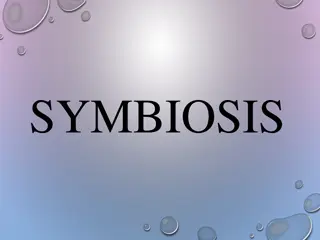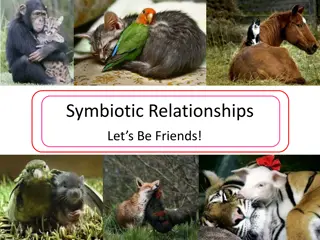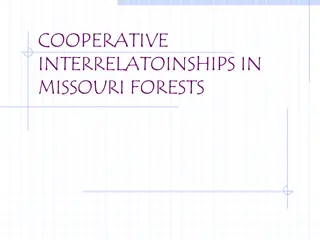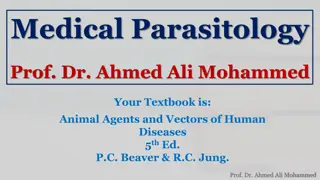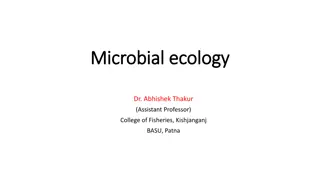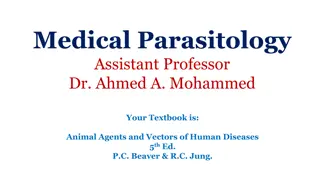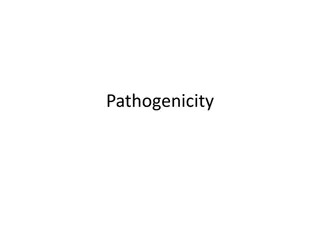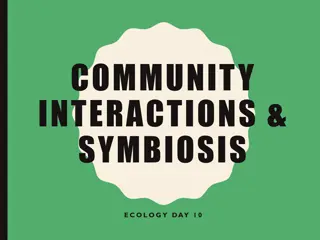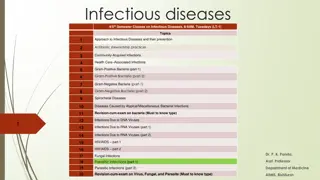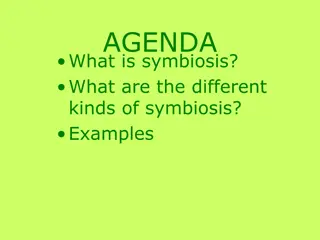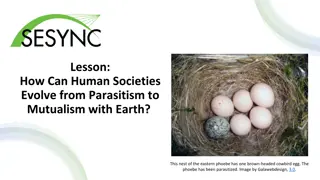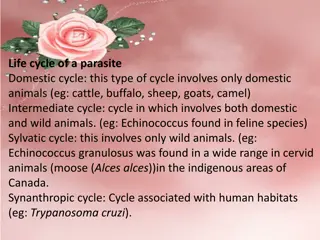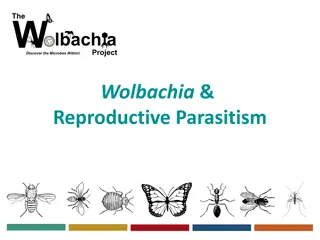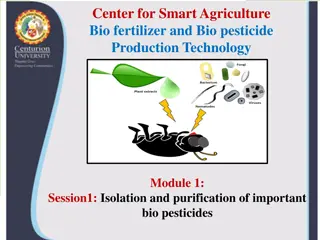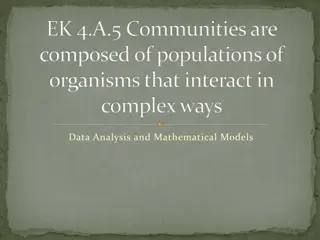Explore Symbiotic Relationships in Nature
Understand symbiosis through examples like mutualism, commensalism, and parasitism. Discover unique partnerships like the Acacia Tree and Ants, Boxer Crab and Anemone, and more. Learn how different species benefit from living together in nature.
0 views • 17 slides
Interactions Among Species in Ecosystems
Understanding species interactions in ecosystems is vital for ecological balance. It involves concepts such as carrying capacity, niche occupancy, and symbiosis. Factors affecting a population's carrying capacity include resource availability, competition, predation, parasitism, and mutualism. Diffe
0 views • 21 slides
Understanding Symbiotic Relationships in Nature
Symbiotic relationships are intricate connections between different species where they benefit from each other. Mutualism, commensalism, and parasitism showcase the diverse ways organisms interact. Examples like decorator crabs with sponges, proboscis butterflies with flowers, and barnacles on whale
1 views • 22 slides
Adaptations in Helminth Parasites: Structural and Morphological Changes
Helminth parasites exhibit adaptations for successful living within hosts, involving structural modifications such as degeneration and new organ formation. Parasitism has evolved over time, leading to a dependent relationship between parasites and hosts. The adaptations in locomotory, digestive, and
1 views • 19 slides
Exploring Symbiotic Relationships in Missouri Forest Ecosystems
Delve into the intricate web of cooperative interrelationships within Missouri forests, where diverse communities coexist in a delicate balance. Discover the concept of ecosystems, from deserts to lakes, and learn about symbiosis through examples of parasitism and commensalism. Explore the fascinati
0 views • 18 slides
Understanding Parasitism in Medical Parasitology by Prof. Dr. Ahmed Ali Mohammed
Prof. Dr. Ahmed Ali Mohammed delves into the intriguing world of parasitism, exploring the complex relationships between parasites and hosts. He explains the various types of relationships in parasitology, such as symbiosis, mutualism, commensalism, and parasitism, shedding light on how parasites in
0 views • 23 slides
Understanding Microbial Ecology: Interactions and Associations in Ecosystems
Interactions of organisms in ecosystems play a crucial role in the functioning of microbial ecology. Dr. Abhishek Thakur explores symbiosis, mutualism, syntrophism, commensalism, predation, and parasitism, shedding light on how different organisms interact with each other and their physical environm
0 views • 9 slides
Understanding Parasitic Relationships in Medical Parasitology
Medical Parasitology delves into the intricate relationships between parasites and their hosts, encompassing symbiosis, mutualism, commensalism, and parasitism. The success of a parasite hinges on achieving a delicate balance with its host, avoiding expulsion or harm. Various types of parasites are
0 views • 12 slides
Understanding Pathogenicity in Infectious Diseases and Parasitism
Pathogenicity refers to the ability of a pathogen to cause disease in plants, humans, and animals. Infectious diseases and parasitism play key roles in the spread and development of epidemics. Parasites can hinder the normal growth of plants by extracting nutrients, while different types of parasite
0 views • 5 slides
Understanding Parasitic Lifecycles and Evolution in Biology
Explore the intricate world of parasites and their lifecycles, from Protists to Bacteria, understanding how parasitism is a successful survival strategy. Discover the diversity of parasites, their lifecycle complexities, and the importance of multiple hosts in parasite development through examples l
0 views • 6 slides
Understanding Community Interactions and Symbiosis in Ecology
Explore the dynamics of community interactions, including competition and symbiosis, in ecological systems. Learn about mutualism, parasitism, and commensalism as examples of symbiotic relationships within ecosystems. Understand the implications of the competitive exclusion principle and how species
0 views • 10 slides
Exploring Community Ecology: Interactions in Ecosystems
Community ecology, as presented by Mr. Nitin A. Ghorpade, delves into the dynamics of species interactions within ecosystems. It covers concepts like communities, individualistic vs. interactive hypotheses, interspecific interactions, predation, parasitism, plant defenses against herbivores, and mor
0 views • 23 slides
Understanding Parasitism in Veterinary Medicine
Parasites can cause significant harm to animals by interfering with normal physiological processes. They can be ectoparasites (external) like mites and ticks, or endoparasites (internal) such as roundworms and hookworms. Diagnosis of parasitism is crucial for effective treatment, with common species
0 views • 27 slides
Comprehensive Overview of Infectious Diseases and Symbiosis in Academic Setting
This academic course covers a wide array of topics related to infectious diseases, including antibiotic stewardship, bacterial infections, viral diseases like HIV/AIDS, fungal and parasitic infections, and parasite life cycles. Additionally, it delves into the intricacies of symbiosis, exploring com
0 views • 24 slides
Understanding Relationships Between Organisms in Nature
Explore the various relationships between organisms in nature, including intraspecific and interspecific interactions such as competition, predation, and parasitism. Learn how organisms compete for resources, hunt and protect themselves, as well as how parasites survive on host organisms. Delve into
2 views • 13 slides
Understanding Symbiosis: Types and Examples
Symbiosis is the act of living together, where two organisms coexist either temporarily or for an extended period. This relationship can be mutualistic, where both organisms benefit, commensalism with one benefiting and the other unaffected, or parasitism, where one benefits at the expense of the ot
0 views • 10 slides
Understanding Parasitology: A Comprehensive Overview
Parasitology is the study of parasites, their hosts, and the interactions between them. This field explores the different aspects of parasitism, including the relationships between parasites and hosts, the classification of major parasite groups like protozoa, helminths, and arthropods, and terms cr
0 views • 16 slides
Ecology Test Review Questions and Answers
Test your ecological knowledge with these questions covering topics like organism interdependence, symbiotic relationships, energy flow in ecosystems, and more. Explore concepts of commensalism, mutualism, and parasitism while learning about the roles of different organisms in maintaining ecosystem
0 views • 30 slides
Cuckoo Search: A Nature-Inspired Optimization Algorithm
Cuckoo Search (CS) algorithm, developed in 2009, mimics the brood parasitism of cuckoo species and utilizes Lévy flights for efficient optimization. This algorithm has shown promise in outperforming other traditional methods like PSO and genetic algorithms. The behavior of cuckoos in laying eggs an
0 views • 25 slides
Understanding Marketing Communications and Unfair Competition Laws
The presentation explores the connection between marketing communications and unfair competition, emphasizing the distinctions between fair and unfair behaviors in the competitive landscape. It delves into definitions of marketing, marketing communication, and types of competitive behavior, highligh
0 views • 14 slides
Evolving Human Societies: From Parasitism to Mutualism with Earth
Human societies can transition from parasitic relationships with the Earth to mutualistic ones, mirroring examples from nature. Explore the concepts of parasites and mutualists in both ecological and human contexts, and consider Earth as a host and organism interconnected in delicate balance. Reflec
0 views • 7 slides
Understanding the Complexities of Parasite Life Cycles and Host Interactions
Parasites exhibit diverse life cycles and behaviors, with cycles ranging from domestic to sylvatic environments. Factors influencing parasite diseases include host specificity, immunity, and host-parasite interactions. Parasitism can alter host behavior, impacting ecological dynamics. Immunology pla
0 views • 9 slides
Understanding Wolbachia: Reproductive Parasitism and Control Strategies
Wolbachia is a fascinating bacterium known for inducing reproductive parasitism in arthropods, affecting their offspring's sex ratios and survival. This article explores the impact of Wolbachia on different species, genetic crosses, cytoplasmic incompatibility, and vector control strategies such as
0 views • 5 slides
Understanding Plant-Nematode Interaction: Defense Mechanisms and Parasitism
In the intricate relationship between plants and parasitic nematodes, plant defenses play a crucial role in combating biotrophic pathogens. The nematodes exploit various strategies to suppress these defenses and establish successful parasitism. The defense mechanisms of plants involve pre-existing b
0 views • 13 slides
Dermatological Conditions: Pityriasis and Hyperkeratosis Overview
Pityriasis is characterized by bran-like skin scales due to overproduction of keratinized cells, with primary and secondary forms and associated causal factors. Hyperkeratosis, on the other hand, results from excessive keratinization causing accumulation of epithelial cells on the skin, with localiz
0 views • 22 slides
Understanding Trichoderma: Isolation, Cultivation, and Applications in Biopesticides
Trichoderma, a genus of fungi, is utilized as a biopesticide for controlling fungal diseases in plants. This article covers the isolation and purification process of Trichoderma, its cultural characteristics, and its important role in smart agriculture bio-fertilizer production. Various strains of T
0 views • 22 slides
Understanding Population Interactions in Communities
Communities are made up of populations of organisms that interact in various ways, shaping the structure of the community. Population interactions include predator-prey relationships, symbiotic interactions like mutualism and commensalism, parasitism, and competitive exclusion. These interactions in
0 views • 25 slides
Understanding Symbiotic Relationships in Nature
Symbiosis is the act of organisms living together, benefiting each other or having one organism harmed while the other benefits or remains unaffected. It includes mutualism, parasitism, and commensalism, each showcasing different types of interactions in nature. Examples such as flowers and insects
0 views • 12 slides
